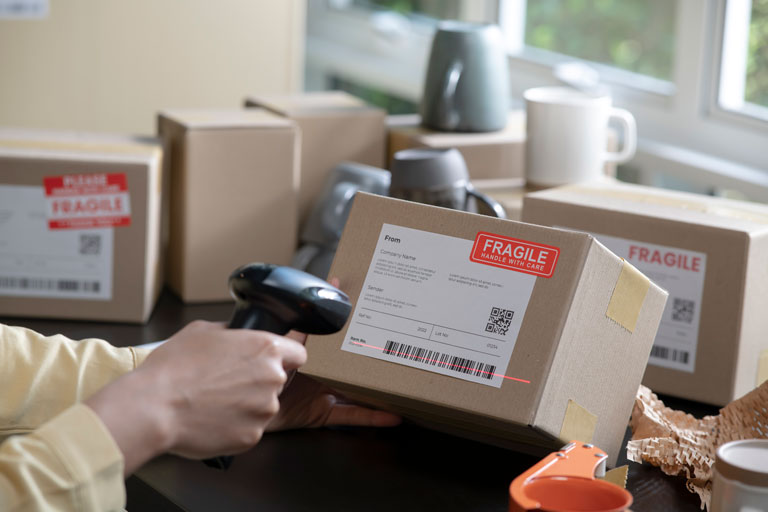When starting a business, you may find yourself lost when it comes to understanding product codes such as SKUs, UPCs, and PLUs.
When starting a business that sells grown or manufactured items such as grocery or retail, you will want to be sure your inventory management is on point with the best practices.
To do so, you will need to understand the basics of the different inventory management codes. This guide is aimed at getting you the most knowledge you could ever need concerning these 3 code types. And in doing so, your business will be one streamlined machine.
History of the Barcode
The first time retail point-of-sale used a barcode to scan a product at checkout was in 1974 in Ohio, on a package of Wrigley’s Juicy Fruit gum. Since then, it is a very common practice amongst all merchants in retail.
Not to confuse a barcode with a QR code, a barcode is a linear image with black and white lines alternating in thickness that is a scannable representation of its UPC number. So what is the difference between a UPC vs a barcode? We will take a further look below.
What is a UPC Number?
A UPC code means Universal Product Code. It is a universal 12-digit number that sits under its corresponding barcode. It is used to identify a specific product within the market. A product in one store will have the same UPC as the same product in another store from a completely different merchant.
UPC codes are a type of Global Trade Item Number (GTIN) used externally from the merchant’s store as a way to accurately track products as they move throughout the market and supply chain. UPC numbers not only keep track of items within the market but also help manage a merchant’s internal inventory.
The ability to scan UPC numbers increases merchant productivity and inventory tracking efficiency. Rather than manually entering an item’s UPC, the barcode allows an item to be scanned and instantly brought up in the company’s inventory system.
Who Creates UPC Numbers?
UPCs are not generated by the merchant. But rather, they are randomly generated by the product manufacturer for the nonprofit Global Standards Organization (GS1 US). This organization is responsible for upholding global business standards and compliance regulations.
Once these codes are generated, a product manufacturer and supplier would then need to license and purchase a UPC from the GS1 for each product.
UPC Breakdown
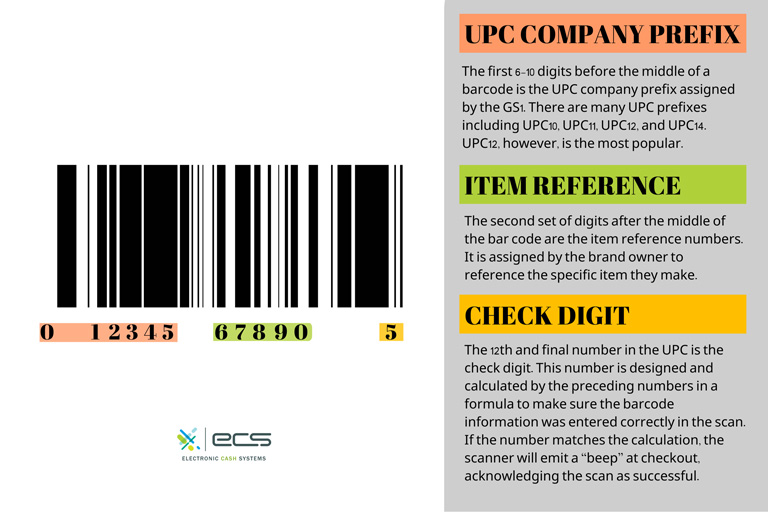
UPC company prefix: The first 6-10 digits before the middle of a barcode is the UPC company prefix assigned by the GS1. There are many UPC prefixes including UPC10, UPC11, UPC12, and UPC14. UPC12, however, is the most popular.
Item reference: The second set of digits after the middle of the bar code are the item reference numbers. It is assigned by the brand owner to reference the specific item they make.
Check digit: The 12th and final number in the UPC is the check digit. This number is designed and calculated by the preceding numbers in a formula to make sure the barcode information was entered correctly in the scan. If the number matches the calculation, the scanner will emit a “beep” at checkout, acknowledging the scan as successful.
Are Barcodes and UPC the Same Thing?
UPC company prefix: The first 6-10 digits before the middle of a barcode is the UPC company prefix assigned by the GS1. There are many UPC prefixes including UPC10, UPC11, UPC12, and UPC14. UPC12, however, is the most popular.
Item reference: The second set of digits after the middle of the bar code are the item reference numbers. It is assigned by the brand owner to reference the specific item they make.
Check digit: The 12th and final number in the UPC is the check digit. This number is designed and calculated by the preceding numbers in a formula to make sure the barcode information was entered correctly in the scan. If the number matches the calculation, the scanner will emit a “beep” at checkout, acknowledging the scan as successful.
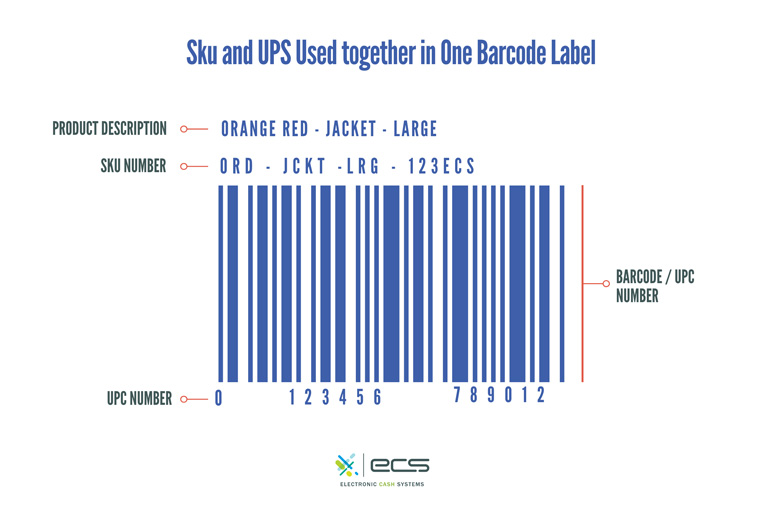
What is an SKU Number?
In contrast, Stock Keeping Units (SKUs) are for internal use only. SKUs have a unique set of alphanumeric characters that a merchant can assign to their individual products.
The term alphanumeric means there are letters and numbers combined in the code to allow for a more diverse system. All SKUs are unique to the retailer. There is no set amount of digits that the retailer is required to use. However, most stick with 6-12 digits.
What Are SKUs For?
A retailer assigns SKU codes to products and then inputs the code into their inventory or POS system. SKUs optimize customer experience and inventory tracking management.
Proper inventory analysis can help merchants design the most efficient shopping experience for customers. And in doing so, they can determine which products are creating profit and which are not. Below are a few specific examples of how SKUs work:
Inventory Management
The core function of SKUs is to create an efficient inventory management system. SKUs help merchants track inventory levels, flow, and sales. The numbers generated by this analysis help retailers know when to order more items from manufacturers based on popularity. Or when to discontinue items that are not selling well.
Customer Assitance
When customers are looking for a particular item at a retailer, associates can look up or scan an SKU to locate their stock status. This type of quick assistance can increase the overall customer experience.
Who creates SKU Numbers?
Retailers create SKU numbers. Because of this, these special characters are merchant specific. They are not universal. SKUs are generated manually, or with an online generator. It would depend on how much inventory a merchant has and how much time they want to dedicate to determining their item-specific codes.
Creating SKUs
Creating SKUs is a way merchants can design an efficient inventory tracking system unique to their store. Custom SKUs help merchants easily differentiate specific product information. A store’s unique SKU code typically uses attributes like cost, brand, manufacturer, size, color, style, warehouse location, and condition within its creation formula. If a clothing store is creating an SKU for an apparel item, the merchant can use unique identifiers in the SKU to differentiate the characteristics of the item. A retailer should additionally, create an SKU naming system to keep track of their codes. Let’s take a look at some SKU samples below:
| Clothing Item | Size | Color |
|---|---|---|
| A = accessories S = shoes D = dress B = bottoms T = top | 0 = extra small 1 = small 2 = medium 3 = large 4 = extra large | BLK = black BLU = blue RED = red GRN = green WT = white YLW = yellow PNK = pink BRN = brown |
SKU example:
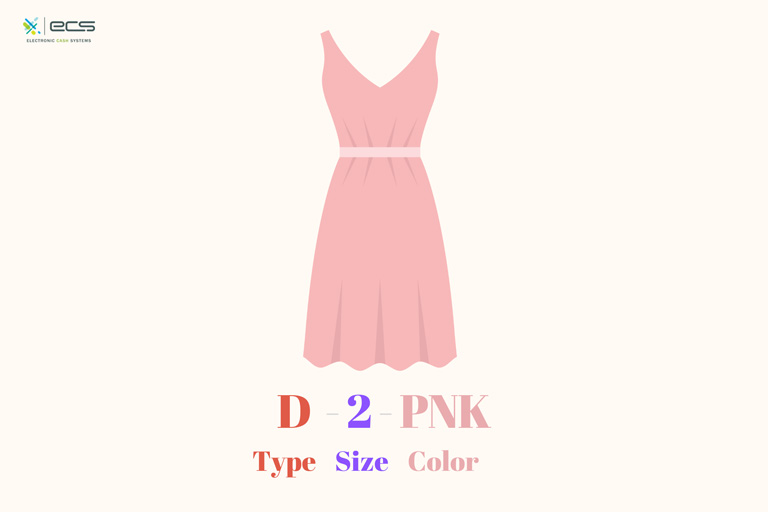
So for example, if a merchant were to create an SKU for a medium pink dress it would read: D-2-PNK
Or if another merchant sold jeans, they could have a different SKU system like the following example:
| Brand | Size |
|---|---|
| LEV =Levis WRGLR =Wrangler TRU = True Religion LEE = Lee CALV = Calvin Klein GUESS = Guess JOE = Joes | 23-60 = waist size |
| Color | Style |
|---|---|
| LTBLU = light wash blue MDBLU = medium wash blue DRKBLU = dark wash blue LTBLK = light wash black MDBLK = medium wash black DRK BLK = dark wash black WT= white | BC = boot cut SL = Straight leg FLR = flare SKNY = skinny MOM = mom RPD= ripped |
So for the following pair of jeans the SKU could read: CALV-34-LTBLU- RPD
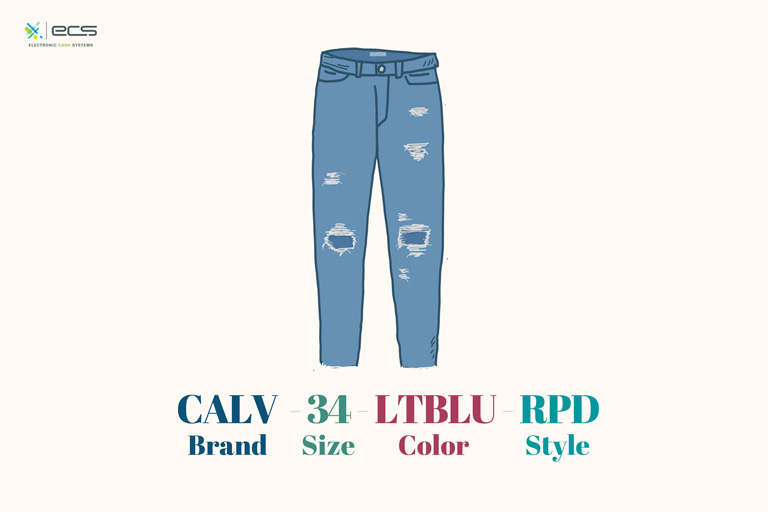
What is a PLU Number?
The third retail code is a PLU. This stands for Price (or Product) Look Up. This is either a 4 or 5-digit number.
Fresh produce sold by weight or quantity uses PLU numbers. Whereas in comparison, a UPC is for packaged products.
Each item has its unique number based on its type and variety. For example, there are different PLU numbers for different varieties and sizes of apples:
4129 – Small Fuji Apple
4131 – Large Fuji Apple
3283 – Honeycrisp Apple
Or Avocados:
4046 – Small Hass Avocado
4225 – Large Hass Avocado
4770 – Extra Large Hass Avocado
4221,4222 – Small Green Avocado
4771 – Medium Green Avocado
Who Creates PLU Numbers?
The International Federation for Produce Standards (IFPS) assigns PLU numbers. Just like UPCs, retailers cannot create these universal codes. If a specific product has no assigned code, a retailer can apply for one with the IFPS.
Because PLUs are universal, different merchant store locations can use them. PLUs can be located in a universal online database from the IFPS.
What Does a PLU Do?
Retailers use PLUs to manage inventory and complete efficient customer check-out. Additionally, the IFPS uses PLUs to analyze and improve the fresh produce supply chain.
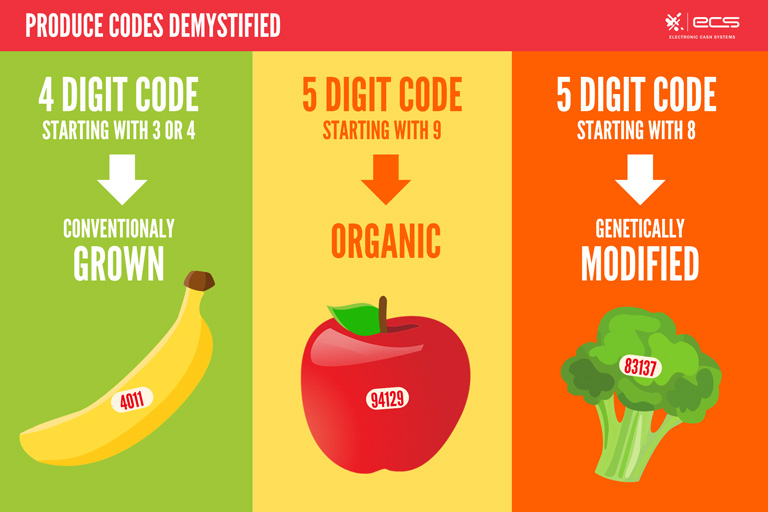
Beyond what was illustrated above, if you are curious if your place of business could benefit from unattended solutions, below is an idea of industries and uses for self-service technology.
Breaking Down PLU Codes
A PLU can start with a 3,4,8 or 9.
If a code is 4 digits and starts with a 3 or 4, this means the produce was conventionally grown. Meaning standard farming procedures with insecticides and pesticides.
If a PLU is 5 digits and starts with an 8, the produce has been genetically modified.
Finally, if a PLU is 5-digits and starts with a 9 the produce is organically grown.
UPC Vs SKU Vs PLU
UPCs, SKUs, and PLUs all serve their own purpose in the world of retail. So how can we differentiate them?
At a glance, the first way you can differentiate between the three is the type and amount of digits used. PLUs are only 4-5 numbers, UPCs are always 12 numbers, and SKUs vary in length. It is also the only code with intermixed letters.
Below is a quick reference chart to explain how each code is unique to the others:
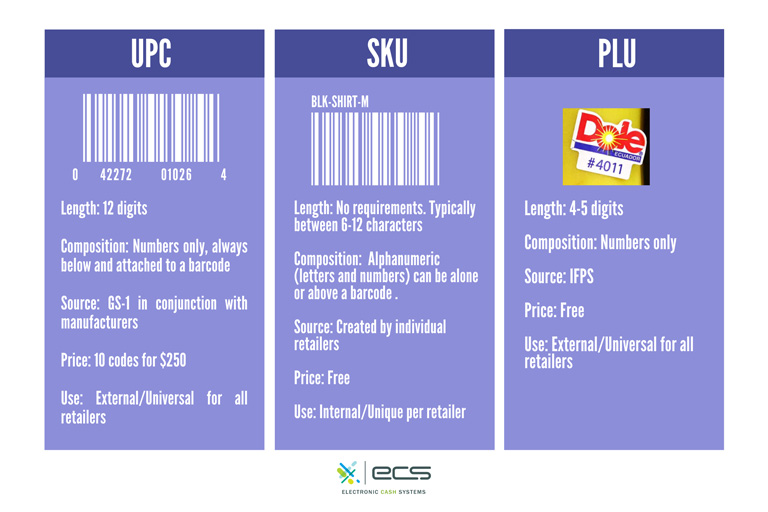
PLUs are typically stand-alone numbers. However, sometimes a scannable barcode is attached. UPCs are always attached to a corresponding barcode, and SKUs are often added on top of the barcode and UPC. Some retailers will add a product description, but it is not necessary.
Do I Need to Use These Codes?
The requirements for using UPCs, SKUs, and PLUs vary depending on a retailer’s industry, size, and where they are selling their product. Different codes will have different requirements.
UPC/Barcode
No law requires merchants to use a UPC or a barcode in their retail shop. However, many merchants choose to use a UPC or barcode because of its efficiency in inventory tracking systems and shipping processes.
Additionally, depending on certain criteria, there may be a requirement to have a UPC/barcode. The below guidelines will help determine if you will need to use them.
You Do Not Need to Use a UPC or Barcode If You:
- sell products directly to customers in person, at farmers’ markets, trade shows, craft fairs, etc.
- sell products directly to customers online through your personal eCommerce website
- sell products directly to customers in an online marketplace such as eBay, Etsy, IndieMade, etc.
- sell products to small local retail stores, as they typically will have their own barcoding system.
- sell products to any additional retail stores that do not require barcodes, such as hotel chains and hospitals, museums, or amusement park gift shops, etc.
You Do Need to Use a UPC or Barcode If You Are a Manufacturer or Merchant That:
- sells products to the US government
- sells products on Amazon
- sells products on any additional online marketplaces that require them
- sell your products to large chain retailers like Target, Walmart, Walgreens, Barnes & Noble, Nutrishop, etc.
- sell to any additional retail stores that require barcodes
SKU For Retail Inventory
There is no law requiring retailers to use SKUs. However, SKU systems are highly recommended. This not only helps with proper inventory management but also helps cashiers and customers during the checkout process.
PLU For Retail Inventory
The government does not require nor regulate PLUs. The PLU system is voluntary for retailers selling produce. However, most retailers in the grocery industry expect to use this system as an aid during the point-of-sale.
In some cases, PLU stickers are on each item like every banana or apple. However, even though all common produce has a PLU some do not make sense to have a sticker label, such as on a singular mushroom, or on bean sprouts.
SKU, UPC, & PLU Final Thoughts
It’s important to maintain and manage a precise organizational structure for your store’s inventory and tracking. Whether your business is using a UPC, SKU, or PLU system, knowing what each code does will help you to maximize profits, serve customers better, create an efficient point-of-sale, track which products are in stock, and identify which products need to be ordered.
Interested in learning more about payment processing? Check out our article on Payment Processing for Beginners
To contact sales, click HERE. And to learn more about ECS Payment Processing visit Credit & Debit.
